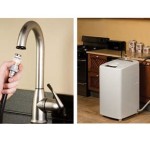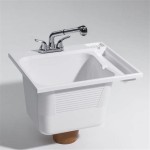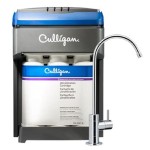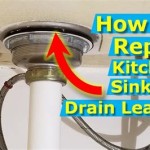Sink Backs Up When Washing Machine Drains: Understanding and Resolving the Issue
Experiencing a sink backing up when a washing machine drains is a common household plumbing problem. While it might seem like an isolated event, it usually indicates a blockage or issue within the drain lines connecting the sink and the washing machine to the main sewer line. Understanding the potential causes and implementing the appropriate solutions can prevent further complications and potential water damage.
The simultaneous use of a washing machine and a sink creates a significant demand on the drainage system. A washing machine, during its drain cycle, expels a large volume of water in a short period. This sudden surge can overwhelm a partially blocked or undersized drain line. Consequently, the water seeks the path of least resistance, often backing up into the sink, which is typically connected to the same drain line.
Several factors can contribute to this situation, ranging from minor clogs to more serious structural problems. Proper diagnosis is crucial for identifying the root cause and selecting the most effective remedy.
Identifying the Common Culprits Behind Sink Backups
Pinpointing the exact reason for the sink backup requires considering several potential causes. A systematic approach to investigating these possibilities can streamline the troubleshooting process and lead to a faster resolution.
One prevalent cause is a partial blockage within the drain line shared by the sink and the washing machine. This blockage could be composed of various materials, including hair, soap scum, lint, food particles, and mineral deposits. Over time, these substances accumulate and constrict the flow of water, creating backpressure when the washing machine discharges its water. The slower drainage from the sink itself might serve as an early warning sign of this developing blockage.
Another possibility is an issue with the vent pipe system. Vent pipes are crucial for maintaining proper air pressure within the drainage system. They allow air to enter the pipes and replace the water flowing out, preventing a vacuum from forming. A blocked or damaged vent pipe can disrupt this airflow, leading to negative pressure within the drain lines. This negative pressure can then pull water from the sink, causing it to back up when the washing machine drains.
Furthermore, the type and age of the plumbing pipes can also play a role. Older homes often have narrower drain pipes, which are more susceptible to blockages and less able to handle the large volume of water discharged by modern washing machines. In addition, deteriorated pipes can be more prone to cracks and leaks, further compromising the drainage system's efficiency. The material of the pipes, such as cast iron, can also contribute to the problem as they are more likely to accumulate rust and corrosion internally, reducing the internal diameter and hindering the flow of water.
Troubleshooting Steps for Sink Backups
Addressing a sink that backs up when the washing machine drains often involves a series of troubleshooting steps. These steps aim to identify and clear any obstructions within the drain lines and assess the overall condition of the plumbing system. It is advisable to proceed with caution and to consider professional assistance if the problem persists or appears complex.
The initial step often involves checking the drain line directly beneath the sink for any visible clogs. The P-trap, a curved section of pipe designed to trap debris and prevent sewer gases from entering the home, is a common location for blockages. Carefully disassemble the P-trap and remove any accumulated debris. Be sure to have a bucket underneath to catch any water that spills out. Reassemble the P-trap tightly after cleaning.
If cleaning the P-trap does not resolve the issue, the next step is to attempt to clear the drain line using a drain snake or auger. This tool can be inserted into the drain opening and pushed through the pipes to break up or retrieve any blockages further down the line. Rotate the snake as it is inserted to help it navigate the bends in the pipes and dislodge any obstructions. Exercise caution not to damage the pipes while snaking them.
Chemical drain cleaners are often marketed as a quick solution for clearing clogs. However, these products should be used with extreme caution, as they can be corrosive and potentially damage the pipes, especially older ones. Furthermore, they may not be effective for all types of blockages and can pose environmental hazards. If chemical drain cleaners are used, follow the manufacturer's instructions carefully and wear appropriate protective gear.
Examining the washing machine's drain hose and filter is also crucial. The drain hose can sometimes become kinked or blocked, restricting the flow of water. Ensure that the hose is properly connected and free of any obstructions. The washing machine's filter, typically located at the point where the drain hose connects to the machine, can trap lint and other debris. Clean the filter regularly to prevent it from becoming clogged and restricting the flow of water during the drain cycle.
Preventative Measures to Avoid Future Backups
Preventing recurring sink backups requires implementing proactive measures to maintain the drainage system and minimize the accumulation of debris. These measures focus on preventing clogs from forming and ensuring proper ventilation within the plumbing system.
Regularly flushing the drain lines with hot water can help to dissolve grease and soap scum before they accumulate and form solid blockages. Pouring a kettle of boiling water down the drain once a week can significantly reduce the build-up of these materials. However, caution should be exercised when using boiling water, especially with PVC pipes, as excessive heat can damage them.
Using drain strainers in both the sink and the washing machine can effectively trap hair, lint, and other debris before they enter the drain lines. These strainers are inexpensive and easy to install, providing a simple yet effective barrier against blockages. Clean the strainers regularly to prevent them from becoming clogged themselves.
Avoid pouring grease, oil, or food scraps down the drain. These materials can solidify and adhere to the inside of the pipes, creating stubborn blockages. Instead, dispose of these items in the trash or compost bin. Similarly, avoid flushing non-biodegradable items, such as feminine hygiene products, wipes, or cotton balls, down the toilet, as they can also contribute to drain line blockages.
Periodically inspecting the vent pipe openings on the roof can help to ensure that they are free of obstructions. Leaves, twigs, and animal nests can sometimes block these openings, disrupting the airflow within the drainage system. Clearing any visible obstructions from the vent pipes can help to maintain proper ventilation and prevent negative pressure from forming in the drain lines.
Consider scheduling a professional plumbing inspection every few years to assess the overall condition of the drainage system. A qualified plumber can identify potential problems, such as corroded pipes or developing blockages, before they become major issues. They can also recommend appropriate maintenance measures to extend the lifespan of the plumbing system and prevent costly repairs.
If the sink backup persists despite these troubleshooting and preventative measures, or if there are signs of more serious plumbing problems, such as slow draining in multiple fixtures or sewage odors, it is essential to consult with a qualified plumber. They possess the expertise and equipment to diagnose the underlying cause of the problem accurately and implement the appropriate solutions. They can also assess the condition of the pipes using specialized tools like cameras to check for cracks or major blockages that are not easily accessible.
Ignoring persistent plumbing problems can lead to more extensive damage and potentially costly repairs. Addressing the issue promptly can prevent further complications and ensure the long-term functionality of the plumbing system. Regular maintenance and proactive measures can significantly reduce the likelihood of experiencing sink backups and other drainage problems.

How To Fix Water Coming Up Through Your Sink From The Washing Laundry Machine Dishwasher

Washing Machine Waste Backing Up To Kitchen Sink Youtube

9 Blocked Sink Waste Problems Cures Q A

Why Is My Washing Machine Backing Up Into Kitchen Sink Yes

Why Is My Washing Machine Backing Up Into Kitchen Sink Yes

Dirty Water In The Drum Hoover Advice Centre

Washing Machine Backs Up Into Kitchen Sink Here S Why

Washing Machine Floods Our Bathroom Sink Bunnings Work Community

Fix That Clogged Laundry Room Sink 1 Tom Plumber

Why Does Water Come Up In The Kitchen Sink Unclog A







